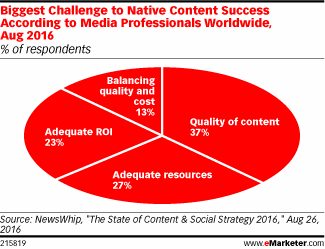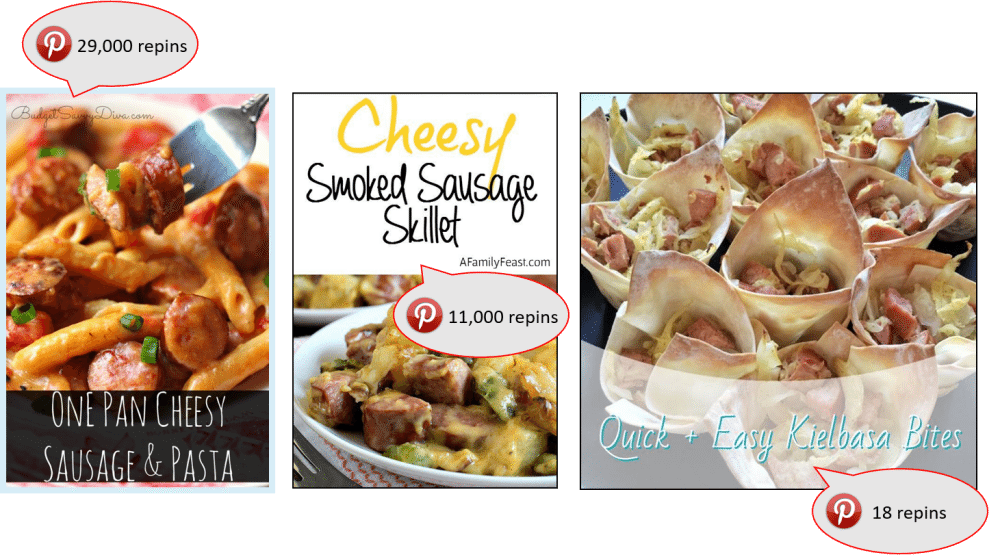Digital Content marketing is getting a lot of attention these days, but is it working?
Content marketing – it’s a phrase that can make marketing executives twitch just a little bit. Digital content marketing is getting so much ink these days that your bosses are expecting blog post + social share = money in the bank. But this study found that 19 out of 20 articles out there don’t contribute to the bottom line. They basically sit there while the 5% do the heavy lifting and drive success.
But here’s the secret: Almost nobody knows which of the 20 pieces of content is really going to take off (although you can make some educated guesses on some pieces that you just know don’t really add value). Since we help major consumer brands solve this problem by creating massive amounts of content, testing it and syndicating the best of it, let’s see how to best deal with the three biggest challenges:
- Lack of quality content;
- Lack of resources; and
- Poor return on investment.
Challenge One: Lack of Quality Content
Over a third (37 percent) of marketers thought quality content creation was the biggest barrier to native content success. In our experience, this can be true. There are a lot of people out there churning out “me too” programs that don’t add anything to the landscape. They’re producing meaningless, inauthentic, copied stuff. They’re often just parroting back what they think a brand wants to hear. This sort of content just adds to the wasteland of crap (excuse us) that’s weighing content marketing down.
Quality content is the crux of the matter. You know it when you see it. When the influencers or brand people produce “thumb-stopping” stuff. It really isn’t hard to find the right influencers to work with … if you know where to look. There are hundreds of niche-specific influencers waiting to work with brands who deliver compelling content that not only resonates with their customer base but gets results – whether it’s increased SOV, sales lift, increased awareness or advocacy.
 High-quality content images from Carusele campaigns for Neutrogena, Hills Bros, Revlon and Canadian Lentils
High-quality content images from Carusele campaigns for Neutrogena, Hills Bros, Revlon and Canadian Lentils
It’s not rocket science but like so many other things in this world, it’s an exercise in relationship-building. We really do want to work with our influencers to make sure the campaign is good for them (beyond the money we pay them). That means that we’ve refined our campaign briefs, advised our clients about what to expect and how to get the best results and above all, we look after our influencers as carefully as we do our clients. The relationships that they forge often become long-standing as influencers start to advocate for brands whose products are a natural fit for their audience.
We’ve found the best content is aspirational or inspirational. But we don’t know before a campaign start which pieces are going to do best. For a sausage brand, one piece of content got over 29,000 repins. Another got only 18. A good system anticipates variable performance and builds it into the model.
Challenge Two: Lack of Resources
It wasn't just content quality that bothered marketers. Twenty-seven percent of those surveyed said a lack of resources prevented them from creating native content.
The cool thing about influencer marketing is that (unlike some other digital platforms) the cost of content creation is included in the cost of an influencer campaign. When brands work with companies like Carusele, they get access to experienced content producers – people who have been proven to produce great content at a reasonable price (without crazy prices being paid to celeb influencers).
 High-quality content images from Carusele campaigns for Häagen-Dazs, Pepsi, Nestlé Damak and Red Nose Day
High-quality content images from Carusele campaigns for Häagen-Dazs, Pepsi, Nestlé Damak and Red Nose Day
But it’s not free. Nor are the millions of other marketing activities that brands undertake. What it is, however, is enormously efficient. We typically deliver 5-10x more impressions than an equivalent budget for targeted banner ads. That brings us to the next challenge: ROI.
Challenge Three: Poor Return on Investment
About a quarter of marketers said native content generated a low return on investment (ROI), rendering content implementation ineffective. It could be that those marketers are spending hours and hours producing those 19 pieces of content that don’t do anything. Because the right programs drive measurable lift in sales. In fact, this highly valid study found that influencer marketing drove 11 times more ROI than other digital media when measured by actual sales lift of the products featured. Again, it comes back to the quality of the content.
Poor quality content = waste of money.
High-quality content = huge ROI (see above), SOV domination, sales lift, advocacy, loyalty … the list goes on.
What's more, influencer content continues to perform well long after a campaign has concluded, providing marketers with lasting results (50 percent of impressions happened after an influencer-led campaign formally came to an end).
Takeaway
So, yes, poor digital content marketing can be a waste of money. Well-intentioned influencers are adding to the landscape of content for content’s sake. You have to prove your marketing dollars are working hard for you and delivering on your objectives. You just need to have the right partners on this journey.
Whether it’s us or someone else, do your homework. Make sure that the influencers you’re going to work with get results. Look for people who are skilled at weaving brands into their existing content – in a way that’s authentic and real.
High-quality native content provides proven ROI and costs less than traditional advertising and digital marketing. However, choosing the right platform and approach is crucial.
-1.png?width=504&height=360&name=Carusele%20logo%20%C2%AE%20logo%20Color%20(2)-1.png)

